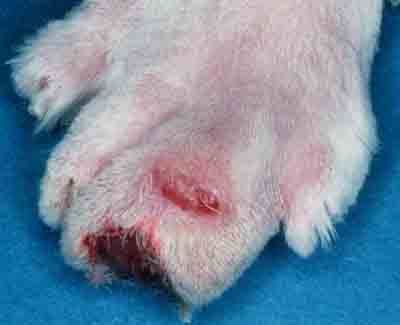Feline cancers refer to the abnormal growth of normal tissue in the body. Old cells wear out and are replaced by new cells. These replacement cells come from parent cells via cell division where copies of the parent cell is created. Cancer starts when a cell has a defect or mutation in its DNA. The Cancerous cell divides out of control which forms into a rumor. A cat rumor can form anywhere in the body including in the skin and bones.
These cells consider to grow and sometimes break off where the blood stream carries cancerous cells via a process called metastasis to other areas of the body. As tumors take hold and grow, they can interfere with organ function. This results in common feline cancers symptoms such s weight loss and lethargy.
Pets can get cancer in the same way that humans get cancer. This is in part to the success veterinarians and medical researchers are having in helping pets to live longer.
Often owners notice a change in behavior or in the cats anatomy such as a visible lump or bump. In feline cancers, the goal during treatment is to maintain a pets quality of life throughout the cat cancer treatment approach.
Even a small cat tumor nodule that is as small as 1 CM (1/2 inch) has 1 billion cat skin cancer cells.

Source: Washington State University
Contents
Why do Cats Get Feline Cancers?
Cat cancer can be caused by things in our environment such as chemicals like lawn insecticides/herbicides, sun exposure and second hand smoke.
Common cat viruses such as the Feline Leukemia Virus, can affect cells and result in mutations which lead to cancer. It usually takes a long period of time for a cats exposure to environmental factors such as lawn herbicides to result in cancer. This is way cancer if more often seen in older cats.
Some breeds are predisposed to cancer because they inherit problems with their immune systems. A cats body should naturally repair mutated cells in the body. However, in some breeds there are problems with the body’s natural ability to repair cells and avoid feline cancers.
Even with the latest research, it is still not known why most cancers form. Feline cancers prevention is best left to avoidance of environmental risks and the maintenance of a healthy diet. This can include the addition of natural antioxidants to a cat’s diet which can help to strengthen cells such as those found in products such as C-Caps.
Early Detection of Feline Cancers
The earlier a cancer is found and diagnosed, the better the cancer outcome. Often signs of feline cancers are mistaken for signs of aging. See the cat cancer detection tips at the end of this article. Also be sure to look for changes in behavior or appearance, such as these cat cancer symptoms listed below;
Cat Cancer Symptoms
- Lameness or stiffness
- Reluctance to exercise
- Loss of stamina
- Weight Loss
- Abnormal swelling
- Sores that do not heal
- Discharge from body openings
- Bad Odor
- Loss of appetite
- Sores that do not heal
- Bleeding from any body opening
- Difficulty breathing, urinating or defecating
Feline Cancers Diagnosis
Diagnosis behinds at the first sign of trouble such as the cat cancer symptoms or behavioral changes noted above. These are off cat skin lumps. A veterinarian will ask when the lump was first noticed.
A test called a fine needle aspiration or biopsy will be taken for analysis. The sample will be checked under a microscope where the cells will be checked by a pathologist. The cells will be classified as being benign (slow growing, not cancerous) or malignant (fast growing, cancerous).
Blood tests, an abdominal ultrasound and CT Scans will help to determine the overall cat health, locations of tumors and how much it might have spread. Based on the diagnosis, the cat cancer treatment options will be determined. The veterinarian can also determine what type of outcome to expect.
Feline Cancers Treatment
Once a specific diagnosis is reached, then treatment items are defined. For benign or non-cancerous cat tumors, a decision might be made to not treat the tumor, but keep an eye on it. This is particularly the case in tumors that are not interfering with the cats quality of life. It is not unusual for a cat to develop multiple feline skin tumors that are benign as it gets older. Any tumors should be noted on a tumor map, that helps track each tumor so that it can be checked for changes.
If malignant cat tumors are found, the vast majority of feline cancers can be treated. This includes a combination of surgical removal of any cat tumor, chemotherapy and radiation. The choice of cat cancer treatment is dependent on your cats health, and the size and location of the tumor. The prognosis, impact on the cats quality of life and financial resources are also important considerations. Treatment in a veterinary hospital often involves multiple doctors. Be sure to ask about any clinical trials that might help pay the cost of care.
Often, owners choose not to treat a malignant tumor because it isn’t impacting a cat’s quality of life. This is a mistake as treating advanced feline cancers are always more difficult to treat.
If you decide not to treat the feline cancer, then you can use nutritional support and minimize symptoms such as helping boost a cats energy and appetite. This is where natural remedies often come in (called palliative care). These include products such as C-Caps which contains natural anti-oxidants to support healthy cell strength and EnergyTonics that help to boost energy. Other approaches include appetite stimulants provided by a veterinarian.
Work with your veterinarian, veterinary oncologist or other specialists to determine the best course of action.
Cat Chemotherapy
One of the the most common type of cancer in cats is lymphoma, resulting in a mass in the intestinal tract. Chemotherapy is often the selected treatment approach. Each treatment starts with a blood test to see if there are still signs of lymphoma and the blood count to see if the cat is healthy enough for treatment. The chemotherapy medications are injected through a catheter in the back leg. Treatments can last as long as 6 months. Cat chemotherapy start weekly for several months, and then move to 2 weeks to 3 weeks. Different medications are used, since different drugs target different types of cells.
In general, cats have less side effects from chemotherapy than humans. In some cases it is not a cure, but it can extend the cat’s lifespan.
Types of Feline Cancers and Treatment
Feline Lymphoma:
This is the most common type of feline cancer malignancy. There are several types of cat lymphomas including:
- Alimentary: Involves the lymph nodes and the intestines and/or gastrointestinal tract. Cat Lymphoma symptoms include anorexia, diarrhea and vomiting.
- Mediastinal: This type of cancer refers to any type of benign or malignant mass, such as a mass in the lungs. Cat cancer symptoms associated with this type of cancer include difficulty breathing (dyspnea), exercise intolerance and cough.
- Multicentric Lymphoma: A type of feline lymphoma that occurs in multiple body sites at the same time.
- Extranodal: The catch all category of cat lymphoma that includes all types of feline lymphoma not categorized in any of the above.
Cat lymphoma is thought to be systemic in that it spreads through the body. For this reason, chemotherapy is often used to treat the disease (medications include vincristine, cyclophosphaminde, prednisolone, doxorubicin). Cats that are FeLV negative that go into remission, often stay in remission for longer than 6 months. FeLV positive cats have shorter remission spans.
Feline Squamous Cell Carcinoma (SCC):
This is a type of cat skin cancer or tumor (about 15% of cat skin tumor cases). These types of feline tumors are most often on the head and areas not covered by cat hair. Researchers believe that this type of cancer, since it occurs on exposed skin, might be caused by sun exposure. About 1/3 of cats have more than one lesion. Cat skin lesions may first appear to scab and then heal.
Skin lesions are removed with a combination of cryosurgery (freezing) and surgery. Chemotherapy for feline squamous cell carcinoma is not consistently effective. Radiation is effective for certain forms of this feline cancer (actinic keratosis)
Feline Mast Cell Disease (feline MCD)
There are several types of feline mast cell disease. This includes:
- Splenic Feline Mast Cell Tumors: This form of feline cance ris often seen in the spleen of older cats that are not pure bred. Symptoms include vomiting.Feline splenic mast cell tumors are treated by removing the cat spleen (splenectomy). Cats undergoing treatment last for this disease. The survival time for cats that undergo a feline splenectomy is 12 months. Cats are given anthimtamines to protect against damage in the gastrointestinal tract.
- Intestinal Cat Mast Cell Tumors: These cat tumors are found in the small intestine. Symptoms include vomiting, lack of appetite and loss of weight.
- Cutaneous feline mast cell tumors: These types of cat tumors are found in all cats, regardless of age. They are often seen on the neck and head, and in the Siamese breed.
Vaccine-Associated Feline Sarcoma
It is widely believed that this type of feline cancer is caused by vaccination. Often a cat skin lump will form after vaccination. Almost all cats develop these lumps after being vaccinated for FeLV and Rabies. In most cases the lumps go away on their own in 2 to 3 months. To avoid cancerous development, if lumps do not heal after 3 months, veterinarians recommend removing the lumps.
Feline Cancers Prevention
Cats should have 2x yearly wellness exams where your pet can be checked for feline cancers, particularly in an older cat
Owners should check a cats body including the skin, mouth, mammary glands and lymph nodes. Ask your veterinarian to review what is normal and how to do a monthly cat skin examination. Run your hands under the cats hair coat and feel the deeper tissue under the skin.
Cat mammary glands can be felt across the abdomen. These are small and shouldn’t be that easy to feel. The lymph nodes are below the jaw, in front of the shoulder, in the arm pit, groin and behind the knee. Gently pinch and slide the node. Normal cat lymph nodes are small and soft. If the cat lymph node feels hard, tell your veterinarian.
When looking for cat mouth cancer, look in the mouth for bad breath or bleeding. Be sure to monitor old tumors and note any new cat mouth tumors and speak to your veterinarian.
If you do find cat skin tumors, ask your veterinarian to create a skin tumor map so that each tumor can be tracked.
References:
Cornell University School of Veterinary Medicine
Cat Cancer from the Cat Heath Guide
Decision making in feline cancer patients David J. Argyle BVMS, PhD, DECVIM-CA (Oncology), MRCVS Royal (Dick) School of Veterinary Studies Hospital for Small Animals, Easter Bush, Midlothian
From Feline Cancers to More Information on Cat Health
To Pet Health Guide Home




